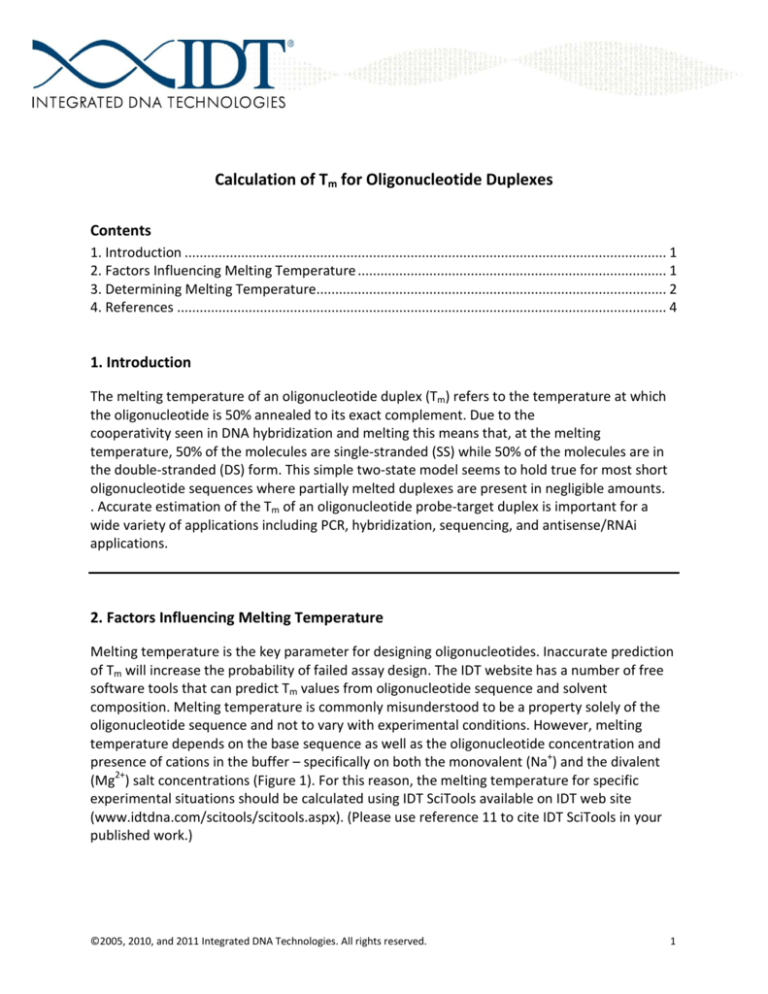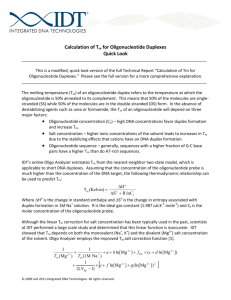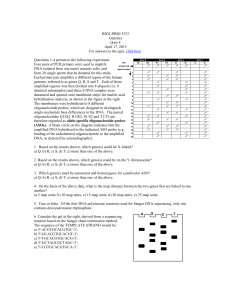
Calculation of Tm for Oligonucleotide Duplexes
Contents
1. Introduction ................................................................................................................................ 1
2. Factors Influencing Melting Temperature .................................................................................. 1
3. Determining Melting Temperature............................................................................................. 2
4. References .................................................................................................................................. 4
1. Introduction
The melting temperature of an oligonucleotide duplex (Tm) refers to the temperature at which
the oligonucleotide is 50% annealed to its exact complement. Due to the
cooperativity seen in DNA hybridization and melting this means that, at the melting
temperature, 50% of the molecules are single-stranded (SS) while 50% of the molecules are in
the double-stranded (DS) form. This simple two-state model seems to hold true for most short
oligonucleotide sequences where partially melted duplexes are present in negligible amounts.
. Accurate estimation of the Tm of an oligonucleotide probe-target duplex is important for a
wide variety of applications including PCR, hybridization, sequencing, and antisense/RNAi
applications.
2. Factors Influencing Melting Temperature
Melting temperature is the key parameter for designing oligonucleotides. Inaccurate prediction
of Tm will increase the probability of failed assay design. The IDT website has a number of free
software tools that can predict Tm values from oligonucleotide sequence and solvent
composition. Melting temperature is commonly misunderstood to be a property solely of the
oligonucleotide sequence and not to vary with experimental conditions. However, melting
temperature depends on the base sequence as well as the oligonucleotide concentration and
presence of cations in the buffer – specifically on both the monovalent (Na+) and the divalent
(Mg2+) salt concentrations (Figure 1). For this reason, the melting temperature for specific
experimental situations should be calculated using IDT SciTools available on IDT web site
(www.idtdna.com/scitools/scitools.aspx). (Please use reference 11 to cite IDT SciTools in your
published work.)
©2005, 2010, and 2011 Integrated DNA Technologies. All rights reserved.
1
Figure 1. Effect of oligonucleotide
length on melting profile. Melting
profiles were plotted for
oligonucleotides of 3 different
lengths, each with ~50% GC content,
and resuspended in a typical PCR
buffer (1 mM Mg2+, 50 mM KCl, 10
mM Tris, pH 8.3).
100
% of duplex
80
60
40
20
15 base pairs
20 base pairs
30 base pairs
0
30
40
50
TM
60
70
80
90
o
Temperature ( C)
In the absence of destabilizing agents, such as urea or formamide, the Tm of an oligonucleotide
will depend upon three major factors:
1. Oligonucleotide concentration (Ct): High DNA concentrations favor duplex formation
which will increase the Tm.
2.
Salt concentration: Higher ionic concentrations of the solvent will increase Tm due to the
stabilizing effects that cations have on DNA duplex formation. More cations bind to
duplex DNA than to the component single strands. Different cations may have different
effects on Tm. IDT scientists have found that both Na+ and Mg2+ have effects on
oligonucleotide duplex stability.
3. Oligonucleotide sequence: Generally, sequences with a higher fraction of GC base pairs
have a higher Tm than do AT-rich sequences. However, the Tm of an oligonucleotide is
not simply the sum of AT and GC base content. Base stacking interactions must also be
taken into account, so the actual specific sequence must be known to accurately predict
Tm. The effects of neighboring bases as contributed through base stacking are called
“nearest neighbor effects” and are mathematically accounted for using experimentally
determined nearest neighbor (NN) thermodynamic parameters.
3. Determining Melting Temperature
For oligonucleotides of the length ranges used today (6-60 base pairs), the best method to
estimate the Tm of an oligonucleotide probe-target duplex takes into account all the above
factors, including nearest-neighbor interactions [1-6], salt concentration, and oligonucleotide
concentration. Assuming that the concentration of the oligonucleotide probe is much higher
©2005, 2010, and 2011 Integrated DNA Technologies. All rights reserved.
2
than concentration of DNA target, the following thermodynamic relationship can be used to
predict Tm,
ΔH o
Tm (Kelvin) =
ΔS o + R lnC t
where ∆Ho is the change in standard enthalpy and ∆So is the change in entropy associated with
duplex formation in a 1 M Na+ solution. R is the ideal gas constant (1.987 cal.K-1.mole-1) and Ct is
the molar concentration of oligonucleotide probe.
In recent years, predictive algorithms have been significantly improved; the latest
nearest-neighbor method predicts Tm with a higher degree of accuracy than previously used
methods [7]. Older formulas did not take interactions between neighboring base pairs into
account and so did not provide Tm predictions that are accurate enough for design of some
applications, such as real-time PCR. IDT scientists have published experimental studies on the
effects of Na+, K+, and Mg2+ on oligonucleotide duplex stability and have proposed a model with
increased accuracy [8,9]. Although the linear Tm correction has been used in the past to account
for salt stabilizing effects, melting data of a large oligonucleotide set demonstrated that nonlinear effects are substantial and must be considered [8,9] (Figure 2).
Figure 2. Ion concentration affects
oligonucleotide stability. The stability
of a 25 base pair long duplex (CTG GTC
TGG ATC TGA GAA CTT CAG G) varies
with K+ and Mg2+ concentrations.
Competitive binding of these cations
to DNA is observed.
76
o
T M ( C)
74
72
70
68
66
100mM
64
1M
10mM
100mM
[K +
]
10mM
+
g
[M
1mM
]
1mM
IDT scientists showed that Tm depends on both the monovalent (Na+, K+) and the
divalent (Mg2+) salt concentration of the solvent. The OligoAnalyzer tool on the IDT website
employs the improved Tm salt correction function [9].
1
1
=
+ a + b ln[Mg 2+ ] + f GC × (c + d ln [Mg 2+ ])
2+
Tm (Mg ) Tm (1 M Na + )
1
+
× e + f ln[Mg 2+ ] + g (ln[Mg 2+ ] ) 2
2( N bp − 1)
[
©2005, 2010, and 2011 Integrated DNA Technologies. All rights reserved.
]
3
Table 1. Parameters for above equation in reciprocal Kelvins.
parameter
value (K-1)
standard error (K-1)
a
3.92 x 10-5
0.2 x 10-5
b
-9.11 x 10-6
0.5 x 10-6
c
6.26 x 10-5
0.4 x 10-5
d
1.42 x 10-5
0.08 x 10-5
e
-4.82 x 10-4
0.7 x 10-4
f
5.25 x 10-4
0.2 x 10-4
g
8.31 x 10-5
0.2 x 10-5
Multivariate linear regression was used to fit these seven parameters in one step. The experimental data
set consisted of 680 Tm values for 92 unique duplex DNAs measured in various Mg2+ concentrations.
Table 1 presents the set of empirically derived parameters and their errors.
PCR buffers also contain deoxynucleoside triphosphates (dNTPs), which bind magnesium ions
(Mg2+) with much higher affinity than DNA. Since they decrease free Mg2+ activity, the Tm may
be also decreased [9] (Figure 2). The best predictive algorithm considers this effect as well.
IDT SciTools [11] uses nearest-neighbor parameters obtained from the most currently available
publications [2,3,5,6,10]. TM calculations for oligonucleotides containing non-consecutive LNA
nucleotides hybridized to a DNA template use LNA energetic parameters from McTigue [6].
Consecutive LNA nucleotides on a DNA template use parameters based on IDT research data
not yet published. LNA modifications on an RNA template are approximated because nearestneighbor parameters for these specific combinations are not yet available.
4. References
1.
Breslauer KJ, Frank R, et al. (1986) Predicting DNA duplex stability from the base
sequence. Proc Natl Acad Sci U S A, 83(11): 3746−3750.
2.
SantaLucia J Jr. (1998) A unified view of polymer, dumbbell, and oligonucleotide DNA
nearest-neighbor thermodynamics. Proc Natl Acad Sci U S A, 95(4): 1460−1465.
3.
Sugimoto N, Nakano S, et al. (1995) Thermodynamic parameters to predict stability of
RNA/DNA hybrid duplexes. Biochemistry, 34(35): 11211−11216.
4.
Sugimoto N, Nakano S, et al. (1996) Improved thermodynamic parameters and helix
initiation factor to predict stability of DNA duplexes. Nucleic Acids Res, 24(22):
4501−4505.
©2005, 2010, and 2011 Integrated DNA Technologies. All rights reserved.
4
5.
Xia T, SantaLucia J Jr, et al. (1998) Thermodynamic parameters for an expanded nearestneighbor model for formation of RNA duplexes with Watson-Crick base pairs.
Biochemistry, 37(42): 14719−14735.
6.
McTigue PM, Peterson RJ, Kahn JD. (2004) Sequence-dependent thermodynamic
parameters for locked nucleic acid (LNA)-DNA duplex formation. Biochemistry, 43(18):
5388−5405.
7.
Owczarzy R, Vallone PM, et al. (1997) Predicting sequence-dependent melting stability
of short duplex DNA oligomers. Biopolymers, 44(3): 217−239.
8.
Owczarzy R, You Y, et al. (2004) Effects of sodium ions on DNA duplex oligomers:
improved predictions of melting temperatures. Biochemistry, 43(12): 3537−3554.
9.
Owczarzy R, Moreira BG, et al. (2008) Predicting stability of DNA duplexes in solutions
containing magnesium and monovalent cations. Biochemistry, 47(19): 5336-5353.
10.
SantaLucia J Jr and Hicks D. (2004) The thermodynamics of DNA structural motifs. Annu
Rev Biophys Biomol Struct, 33:415−440.
11.
Owczarzy R, Tataurov AV, et al. (2008) IDT SciTools: a suite for analysis and design of
nucleic acid oligomers. Nucleic Acids Res, 36(suppl. 2): W163−W169.
©2005, 2010, and 2011 Integrated DNA Technologies. All rights reserved.
5







